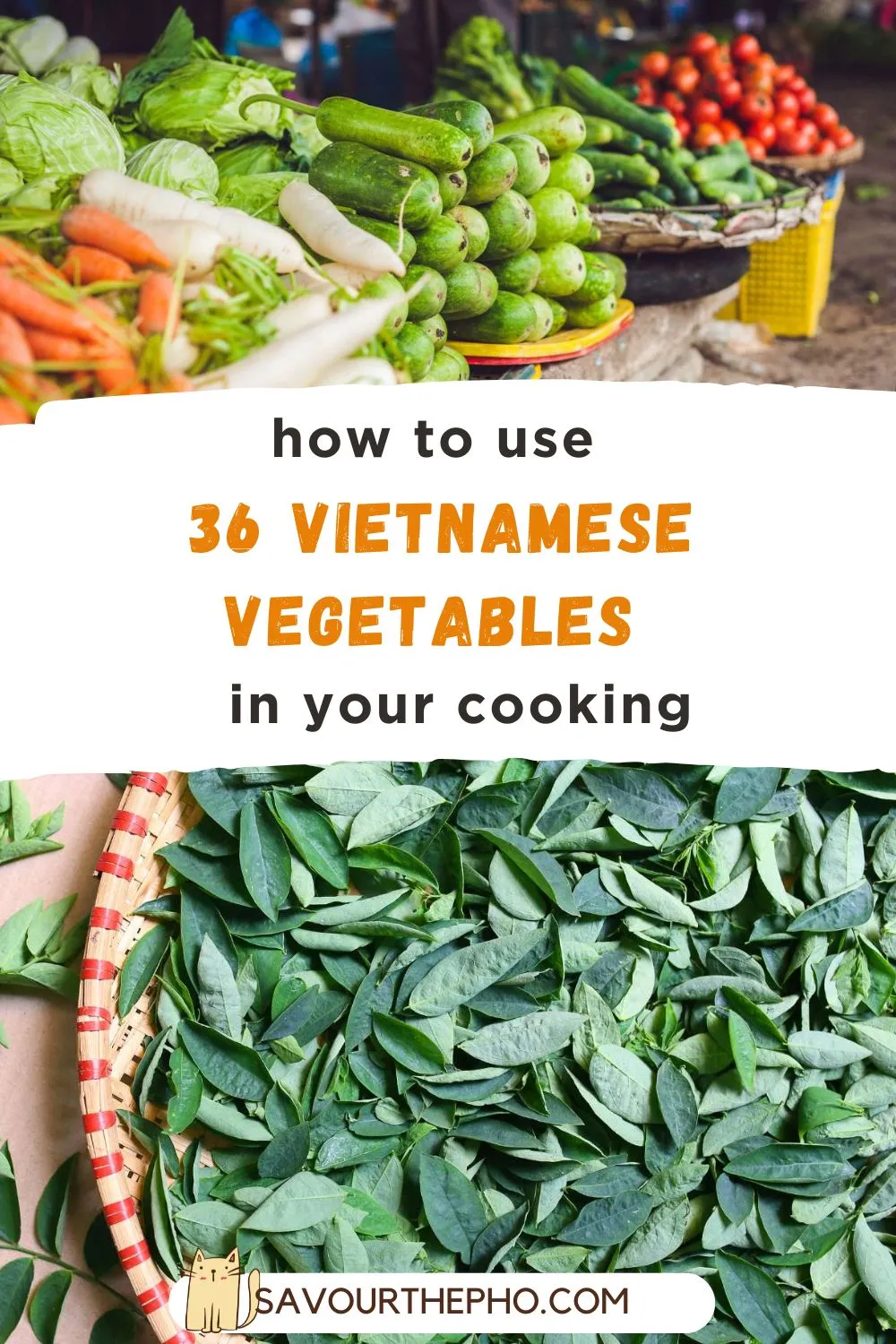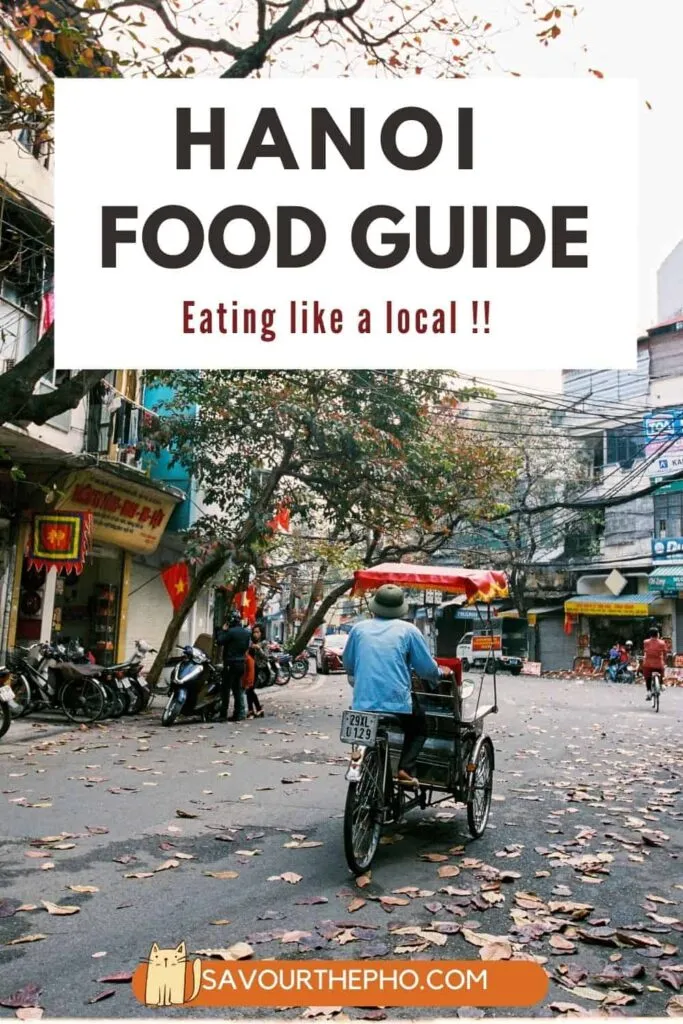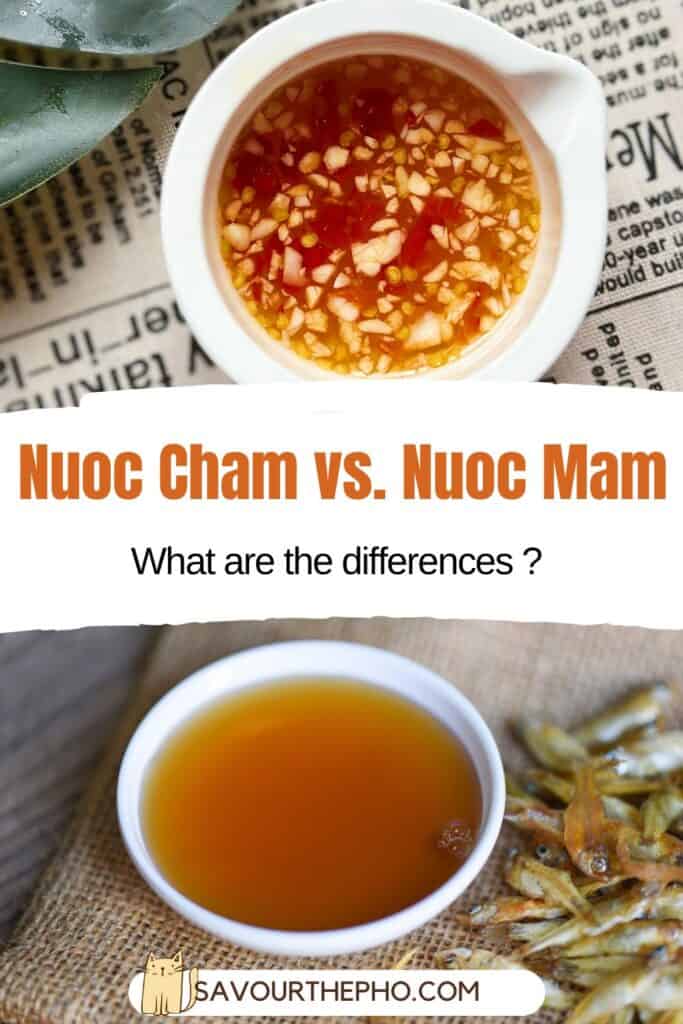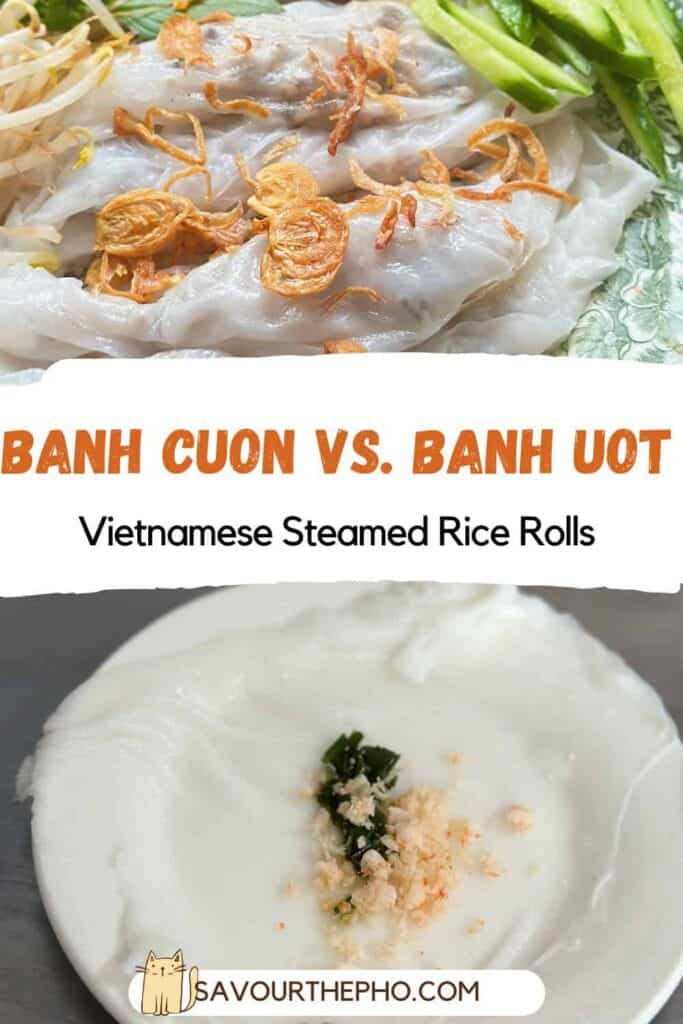In Vietnam, no meal feels complete without a burst of freshness from the garden. A simple family dinner always comes with a plate of herbs and vegetables on the side — they brighten up the flavors and keep the meal light and balanced.

We even have a saying: “Cơm không rau như đau không thuốc” — a meal without vegetables is like being sick without medicine. It’s that important.
You might have already seen me share about Vietnamese fruits and Vietnamese herbs. Today, I want to take you on a little journey into the world of veggies — their names, their stories, and how we use them in our cooking.
1. Rau Muống (Water Spinach / Ong Choy)
If there’s one vegetable that truly speaks “Vietnam” to me, it’s rau muống. This humble, leafy green isn’t fancy, but it’s everywhere — from street stalls to family dinners — and it carries the taste of home.
In Vietnam, we eat it in so many ways, both fresh and cooked. The most iconic (and honestly, the one I crave the most) is rau muống xào tỏi — stir-fried water spinach with garlic. Just a hot wok, sizzling oil, a big handful of greens, and the fragrance of garlic filling the air. Simple, quick, but unforgettable.

You’ll also see rau muống slipping into noodle soups, adding that fresh crunch to every slurp:
- Canh Bún (crab noodle soup with water spinach)
- Bún Riêu (Vietnamese crab noodle soup)
- Bún Bò Huế (Hue’s spicy beef noodle soup)
For me, rau muống isn’t just a vegetable — it’s part of the rhythm of everyday Vietnamese cooking.
2. Giá Đỗ (Mung Bean Sprouts)
In Vietnam, giá đỗ (mung bean sprouts) are as essential as soybean sprouts are in Korean cooking — they’re everywhere. You’ll spot them on the herb plate that always comes with phở, tossed into noodle salads for crunch, quickly stir-fried, or pickled into a refreshing side dish.

A few dishes just wouldn’t be the same without them:
- Bún Bò Xào (Vietnamese beef noodle bowl)
- Bánh Cuốn (steamed rice rolls)
- Dưa Giá (pickled bean sprouts, a Lunar New Year favorite)
- Phở Bò (beef phở)
- Phở Gà (chicken phở)
They might look plain at first glance, but giá đỗ is one of those little touches that bring brightness and balance to Vietnamese food.
3. Cải Bẹ Xanh / Cải Sậy (Gai Choy / Mustard Greens)
Mustard greens are one of those veggies that carry bold character — peppery, pungent, and with just the right touch of bitterness. In Vietnamese cooking, we actually use two types: the big-stemmed mustard cabbage (cải sậy), which leans more bitter and is perfect for pickling, and the leafy mustard greens (cải bẹ xanh), often used as fresh wraps or in everyday dishes.


They’re versatile — great in stir-fries, light soups (canh), and of course, in pickles. Some familiar dishes you might spot them in:
- Bánh Xèo (crispy savory pancakes, where the greens balance out the richness)
- Bánh Khọt (mini savory pancakes)
- Mustard Green Soup
- Dưa Chua (pickled mustard greens)
I have to admit, I’m a huge fan of dưa chua. It’s Vietnam’s answer to kimchi, and to me, nothing pairs better with sườn ram (caramelized pork ribs) or cá kho (caramelized fish). And if you’ve never tried canh dưa chua — pickled mustard green soup — trust me, it’s out-of-this-world good.
4. Cải Làn / Cải Rổ (Gai Lan / Chinese Broccoli)
Cải làn (also known as gai lan or Chinese broccoli) reminds me of regular broccoli, but with a slightly more bitter bite. The stalks are tender, the leaves are full of flavor, and together they make one of the most versatile greens in Vietnamese cooking.

You’ll see it everywhere — tossed into a quick stir-fry, simply blanched for a side of greens, or simmered in a light, comforting bowl of canh.
And just so you know — in Vietnam, when someone says “soup,” they usually mean canh, our everyday light, brothy vegetable soup.
5. Cải Thìa / Cải Chíp (Bok Choy)
Cải thìa (bok choy) is one of those vegetables that feels right at home in so many Asian kitchens, and Vietnam is no exception. Crisp, slightly sweet, and refreshing, it’s the kind of green that never feels heavy — which is probably why it’s become so loved around the world. These days, you can even spot it in Western supermarkets.
You’ll find bok choy in different forms: the mature kind with bigger stalks, the cute baby bok choy, and the popular cải bẹ trắng (Shanghai bok choy) with its dark green leaves and thick white stems.


It’s wonderfully versatile — throw it into a comforting canh (light soup), dip it in a bubbling hot pot, give it a quick stir-fry, or just blanch it for a simple side of greens.
6. Cải Ngồng / Cải Ngọt (Choy Sum / Yu Choy)
At first glance, cải ngồng (choy sum) might look like cải làn (Chinese broccoli), but don’t be fooled — the two are quite different. Choy sum is much more tender, sweeter, and less bitter, with softer stems that cook up beautifully.
Like bok choy, it’s a versatile green that fits just about anywhere — tossed into a light soup (canh), added to hot pot, quickly stir-fried, or simply blanched and served with a drizzle of Chinese garlic sauce.

7. Cải Xoong / Xà Lách Xoong (Watercress)
Cải xoong (watercress) is a leafy green with personality. Raw, it has that bold, peppery kick that wakes up your taste buds. But once it’s cooked, the sharpness softens into something light and comforting.

In Vietnam, we love how versatile it is — it slips easily into a bowl of canh (light soup), works beautifully in salads, and makes a quick, tasty stir-fry. One of my favorite simple ways to enjoy it? Just blanch it and dip it in nước chấm. Fresh, crisp, and so easy.
8. Cải Cúc / Tần Ô (Chrysanthemum Greens / Crown Daisy)
Tần ô (chrysanthemum greens) may sound fancy, but to many Vietnamese families, it’s just a comforting, everyday green with a light, refreshing flavor. The name actually comes from Chinese (tangho/tongho), and you’ll also find it in other Asian kitchens — ssukat in Korean, shingiku in Japanese.

In Vietnam, though, it’s all about simplicity. We toss it into canh rau tần ô (chrysanthemum greens soup), give it a quick stir-fry, or just blanch it for an easy side of greens.
9. Cải Thảo (Napa Cabbage)
In Vietnam, cải thảo (napa cabbage) is treated much like regular cabbage (bắp cải), but it brings a softer, sweeter touch. You’ll often find it floating in a light bowl of canh, adding freshness to a bubbling pot of lẩu Thái (Vietnamese hot pot), tossed into quick stir-fries, or pickled for a tangy side dish.

10. Rau Dền (Amaranth Leaves)
When people outside Vietnam hear “amaranth,” they usually think of the seeds or flour. But for us, it’s the greens — rau dền — that really shine at the table.
These leaves come in gorgeous shades, from bright green to deep red or purple streaks, depending on the variety. Flavor-wise, they’re a bit like spinach but with a sturdier, heartier texture that holds up beautifully in cooking.

One of the most common (and comforting) ways we enjoy rau dền is in canh — those light, everyday soups that round out a family meal. Simple, colorful, and nourishing, it’s the kind of dish that quietly feels like home.
11. Mồng Tơi (Malabar Spinach)
Rau mồng tơi (Malabar spinach) is one of those greens that feels extra special to me because of my mom. She loves it so much that she grows it in our home garden, and there’s always a fresh bunch waiting to be picked.

Its flavor is gentle — a little like spinach, but with a mild peppery note and a tiny hint of citrus. We usually keep the cooking simple: blanched, quickly stir-fried, or added to a bowl of canh for a light, flavorful soup.
12. Cần Tây / Cần Tàu (Chinese Celery)
In Vietnam, celery can be a little tricky to name. Depending on the region, you’ll hear cần tây or cần tàu for Chinese celery. To make it more confusing, regular Western celery is also called cần tây!

Compared to the thick, crunchy Western variety, Chinese celery is slimmer, more aromatic, and has a lighter crunch. We often toss it into fish soups, but where it really shines is in stir-fries — especially with squid or beef. The celery adds a fresh bite that balances the richness of the protein, making the whole dish feel brighter.
13. Cần Nước / Cần Ta (Water Celery)
Rau cần nước (or cần ta) is another fragrant green you’ll often find in Vietnamese kitchens. It’s used much like Chinese celery, adding a light, herbal crunch to stir-fries and soups.

In the North, though, cần ta is the signature green for bún cá rau cần (Northern-style fish noodle soup). Without it, the dish just wouldn’t taste the same.
14. Rau Lang (Yam Leaves/Sweet Potato Leaves)
In Vietnamese cooking, we’ve always believed in using every part of an ingredient — nothing goes to waste. From stir-frying broccoli stems to pickling watermelon rinds, even the tender leaves of the sweet potato plant (rau lang) find their way onto the table.

The flavor is gentle and comforting — mild, a little sweet, with just a hint of bitterness. Simple, wholesome, and so versatile. Whether quickly stir-fried with garlic, lightly blanched, or added to a pot of canh, rau lang is one of those humble greens that quietly complete a family meal.
15. Rau Má (Pennywort)
If you’ve ever spent a summer in Vietnam, you’ll know that nothing cools you down quite like a glass of nước rau má (pennywort juice). It’s refreshing, earthy, and somehow feels instantly revitalizing after the heat.
For a more indulgent version, we love rau má đậu xanh cốt dừa — pennywort blended with mung bean paste and coconut milk. Creamy, wholesome, and so satisfying.

Sure, milk tea or matcha latte might be the trendy picks these days, but pennywort juice, soy milk, and even the classic Vietnamese avocado smoothie prove that simple, affordable drinks can be just as delicious — and maybe even more refreshing.
And like so many greens in Vietnam, rau má isn’t just for sipping — it also finds its way into light soups, stir-fries, and fresh salads. Versatile, nourishing, and deeply tied to the rhythm of daily life.
16. Rau Ngót / Rau Bồ Ngót (Katuk / Star Gooseberry Leaves)
Rau ngót (katuk) has this gentle, nutty flavor that reminds me a bit of fresh garden peas. In Vietnam, it’s a favorite for light, comforting soups (canh), often cooked with shrimp or ground pork to bring out its natural sweetness.
Here’s a little tip from home: before cooking, crumple and squeeze the leaves — it helps release their full flavor and makes the soup taste even better.

17. Rau Đay (Egyptian Spinach)
Despite its name, rau đay (Egyptian spinach) doesn’t look or taste like the spinach you might be used to. It has a unique, earthy flavor with just a hint of bitterness that makes it stand out in soups.

In Northern Vietnam, one of the most cherished ways to enjoy it is in canh cua rau đay — a light, comforting soup with loofah gourd and freshwater crabs. Paired with cà muối (Vietnamese pickled eggplant), it’s my dad’s ultimate favorite during the scorching summer months
18. Khổ Qua/Mướp Đắng (Bitter Melon)
Khổ qua (bitter melon) is one of those veggies you either love or love to hate. Kids usually shy away from its bitterness, but adults in Vietnam often can’t get enough.
In the South, its name literally means “overcoming hardship,” which is why canh khổ qua (stuffed bitter melon soup) is a lucky dish during Tet, symbolizing resilience and good fortune.

It’s a classic on the festive table, sitting alongside bánh tét (cylindrical sticky rice) and thịt kho trứng (braised pork and eggs in coconut water). But bitter melon isn’t just for holidays — it’s versatile in everyday cooking, too:
- Stir-fried with eggs (khổ qua xào trứng)
- Chilled with pork floss (khổ qua chà bông)
- Hakka-style stuffed tofu and vegetables (khổ qua cà ớt or yong tau foo)
19. Đậu Bắp / Bắp Còi (Okra)
Đậu bắp (okra) may seem humble, but it’s a beloved veggie all across Asia, from Pakistan to Japan. In Vietnam, it’s a star in canh chua (sweet and sour soup) and even pops up in BBQ dishes for a little extra bite.
At home, my mom keeps it simple — she just boils the okra and serves it with a little chao (fermented tofu dipping sauce).

20. Bắp Chuối (Banana Blossoms)
In Vietnam, the banana plant is like a little gift that keeps on giving. We use the leaves to wrap food, ripe bananas for sweet treats like kem chuối or chè chuối, and even green bananas show up in savory dishes. And yes, the trunk and blossoms aren’t wasted either!

Bắp chuối (banana blossoms) are tender with a subtle crunch, and they shine in so many ways — in soups, tossed into salads, or paired with noodles. Some of my favorites:
21. Bí Xanh / Bí Đao (Wintermelon / Fuzzy Melon / White Gourd)
In Vietnam, bí xanh (winter melon) is known as a “cool vegetable,” perfect for beating the summer heat. It’s incredibly versatile — turning into refreshing soups, stir-fries, sweet treats, and even drinks.

Some of my favorite ways to enjoy winter melon:
- Canh bí (Vietnamese winter melon soup)
- Mứt bí (candied winter melon)
- Winter melon tea
- Winter melon milk tea
22. Bí Ngô / Bí Đỏ (Pumpkin / Butternut Squash)
In Vietnam, pumpkin and butternut squash are everywhere — used in both savory dishes and desserts. One of my favorite daily soups is canh bí đỏ, where pumpkin is cooked with ground pork, shrimp, pork ribs, or giò sống (Vietnamese pork paste).
For me, bí đỏ is also a handy, low-calorie substitute for khoai lang (sweet potato), especially when pumpkin is cheap and in season.

23. Bầu (Gourd / Opo Squash / Calabash)
Bầu (opo squash) has a gentle, mild flavor, a bit like zucchini. In Vietnam, one of the most comforting ways to enjoy it is in canh bầu tôm — a light soup with shrimp that’s simple, fresh, and perfect for everyday meals.

24. Mướp / Mướp Hương (Loofah Gourd)
Most people know loofah as a sponge, but in Vietnam, mướp (loofah gourd) is just as famous on the dinner table. Its flavor is gentle, slightly sweet, and a little like cucumber — light and refreshing.

Some of my favorite simple ways to enjoy it:
- Canh mướp (loofah gourd soup)
- Mướp xào (stir-fried loofah)
It’s also perfect for a Vietnamese-style vegan broth, which becomes the base for many dishes like phở chay or bún bò Huế chay. Mild, versatile, and comforting, mướp is one of those everyday vegetables that quietly makes meals feel wholesome.
25. Su Su (Chayote)
During the French colonization, Vietnam picked up a few tasty influences — think bánh pate sô (Vietnamese meat pies), Vietnamese iced coffee, and creamy bánh flan. Along with these, the French also introduced new crops, including chayote. That’s actually where su su comes from — the Vietnamese way of saying the French chouchou.

In everyday Vietnamese cooking, su su is simple, comforting, and incredibly versatile. One of the easiest ways to enjoy it is su su xào — stir-fried chayote. Tender, mildly sweet, and lightly crisp, it’s the kind of dish that feels like home on a plate.
26. Su Hào (Kolhrabi)
Kohlrabi (su hào) is more of a Northern favorite in Vietnam, but it’s just as versatile as any other veggie. You’ll find it in soups, pickles, and fresh salads.

Some classic ways to enjoy it:
27. Khoai Lang (Sweet Potato / Yam)
In Vietnam, khoai lang (sweet potato) has always had a special place — even more than the regular potato (khoai tây). During the war, when rice was scarce, sweet potatoes were a lifeline, keeping families fed.
Today, you’ll find all kinds of sweet potatoes in Vietnam — the classic orange-fleshed kind, yams, and even the vibrant purple variety (Okinawan sweet potato).

Vietnamese cuisine loves to make the most of them: in crispy fritters, hearty stews, or sweet chè desserts. Some favorites include:
- Bánh tôm chiên khoai lang (shrimp and sweet potato fritters)
- Cà ri gà (Vietnamese chicken curry)
28. Khoai Môn (Taro)
Taro (khoai môn) is a beloved staple in Southern Vietnamese cooking. It has a naturally earthy, nutty flavor with a gentle sweetness that’s comforting without being too strong. It’s also the secret ingredient that gives chả giò (Vietnamese egg rolls) their texture.

Taro also shines in desserts and drinks, where its creamy texture and gentle sweetness really stand out. Some favorites: chè khoai môn (taro pudding), taro milk tea, soft taro buns, and even rich taro ice cream.
29. Khoai Mỡ (Purple Yam / Ube)
I’m a huge fan of ube desserts — from ube halaya to ube leche flan and ube chiffon cake. But in Vietnam, khoai mỡ (purple yam / ube) is mostly celebrated in savory dishes rather than sweets.

The star is canh khoai mỡ (purple yam soup) — a comforting, flavorful soup that turns this vibrant, naturally sweet yam into something warm and homey. It’s simple, nourishing, and a little surprising how such a humble root can bring so much color and depth to a meal.
30. Khoai Mì / Củ Sắn (Cassava)
Khoai mì (cassava) is more than just a root vegetable — it’s a reminder of the tough post-war years in Vietnam, when people had to stretch rice supplies with cassava or sweet potatoes to get by. My grandpa even nicknamed me “Mì” to remember those challenging times.

Despite its humble past, cassava can be transformed into so many delicious dishes:
- Bánh khoai mì nướng (Vietnamese baked cassava cake)
- Bánh tằm khoai mì (cassava silkworm strips)
- Chè khoai mì (sweet cassava dessert soup)
Humble, resilient, and surprisingly versatile — cassava is a taste of history and home in every bite.
31. Bắp / Ngô (Corn)
Corn (bắp) is a staple all over the world, and Vietnam is no exception. It’s incredibly versatile in Vietnamese cuisine — waxy corn (bắp nếp) usually stars in savory dishes, while sweet corn (bắp ngọt) shines in refreshing drinks and desserts.

Some of my favorites:
- Bắp xào (stir-fried corn with dried shrimp)
- Bắp nướng mỡ hành (grilled corn on the cob with scallion oil)
- Sữa bắp (corn milk)
- Xôi bắp (corn sticky rice)
- Chè bắp (sweet corn pudding)
Simple, sweet, and full of comfort — corn has a way of bringing that little extra warmth to everyday meals.
31. Cà Rốt (Carrots)
Carrots (cà rốt), like potatoes (khoai tây) and chayote (su su), were introduced to Vietnam by the French. Over time, they’ve become a kitchen staple, popping up in everything from fresh salads to soups, stews, stir-fries, and pickles.

You’ll find carrots in many dishes like:
- Gỏi cuốn (Vietnamese spring rolls)
- Hủ tiếu bò kho (Vietnamese beef stew with tapioca noodles)
- Súp nui (macaroni soup)
- Ragu gà (Vietnamese chicken ragout)
32. Củ Cải Trắng (Daikon Radish)
If you love Vietnamese food, you’ve probably met đồ chua — those iconic pickled daikon and carrots that add a bright, refreshing crunch to bánh mì, cơm tấm (broken rice), and noodle bowls like bún thịt nướng, bún chả giò, or bún gà nướng.
Daikon (củ cải trắng) isn’t just for pickles — it’s a natural umami booster, quietly adding depth to broths. Just drop a few pieces into your pot and let them work their magic.

Some dishes where daikon shines:
- Hủ tiếu Nam Vang (Phnom Penh-style noodle soup)
- Bánh canh (tapioca noodle soup)
- Miến gà (chicken glass noodle soup)
33. Củ Sắn Nước / Củ Đậu (Jicama)
Originally from Mexico, jicama (củ sắn nước) has made itself at home in Vietnamese kitchens. In Vietnam, it’s often enjoyed raw, paired with a sprinkle of muối tôm (shrimp salt) or muối ớt (chili salt) for a crisp, refreshing bite.
Jicama can be quite pricey in Germany, so good substitutes include canned water chestnuts, or even kohlrabi and daikon if you need a fresh crunch.

It also adds a nice touch to savory dishes like:
- Bò bía (Chinese sausage spring rolls)
- Xíu mại (Vietnamese meatballs in tomato sauce)
34. Cà Tím (Eggplant)
Eggplant (cà tím) is a little magic on the plate. Its spongy texture soaks up flavors beautifully, becoming tender and melt-in-your-mouth when cooked. Perfect for vegan and vegetarian dishes, or just adding a comforting, hearty touch to any meal.

Some tasty ways to enjoy eggplant in Vietnamese and Asian cooking:
- Cà tím nướng mỡ hành (Vietnamese grilled eggplant with scallion oil)
- Vietnamese braised eggplant
- Gochujang-glazed eggplant
- Teriyaki eggplant
- Vegan unagi donburi
35. Cà Pháo (Thai Eggplant)
Cà pháo, or Thai eggplant, is small but full of character. Its crisp, slightly crunchy texture holds up well when cooked, and its mild, subtly bitter flavor pairs beautifully with bold, spicy dishes.
In Vietnam, we often enjoy cà pháo raw, turning it into tangy pickles or fresh salads for a refreshing crunch.

Some ways to enjoy it:
- Cà muối (Vietnamese pickled eggplant)
- Thai red chicken curry (Gaeng Phed Gai)
- Thai green chicken curry (Gaeng Khiao Waan Gai)
36. Măng (Bamboo Shoots)
Bamboo shoots (măng) are loved not just in Vietnam, but across Southeast Asia. In Vietnamese kitchens, you’ll usually find them in three forms: dried (măng khô), fresh (măng tươi), and pickled (măng chua).
Fun fact — we also have măng tây, which is asparagus, often featured in soups like Súp Măng Tây (Vietnamese crab & asparagus soup).


Pickled bamboo shoots add a tangy kick to meals, whether served as a side or cooked into canh măng chua (sour bamboo fish soup). Fresh and dried bamboo shoots are perfect for soups, braises, or stir-fries. Fresh ones give a satisfying crunch, while dried shoots bring a chewy, meaty texture
Some dishes where bamboo shoots shine:
- Bún măng vịt (duck & bamboo shoot noodle soup)
- Bún măng gà (chicken & bamboo shoot noodle soup)
- Stir-fried bamboo shoots
More content about authentic Vietnamese cooking:

You can discover a compilation of Vietnamese recipes on my blog and subscribe for new updates.
And don’t forget to stay in touch with me on Instagram, Facebook, Pinterest, and YouTube 🥰.



